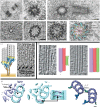Centriole structure
- PMID: 25047611
- PMCID: PMC4113101
- DOI: 10.1098/rstb.2013.0457
Centriole structure
Abstract
Centrioles are among the largest protein-based structures found in most cell types, measuring approximately 250 nm in diameter and approximately 500 nm long in vertebrate cells. Here, we briefly review ultrastructural observations about centrioles and associated structures. At the core of most centrioles is a microtubule scaffold formed from a radial array of nine triplet microtubules. Beyond the microtubule triplets of the centriole, we discuss the critically important cartwheel structure and the more enigmatic luminal density, both found on the inside of the centriole. Finally, we discuss the connectors between centrioles, and the distal and subdistal appendages outside of the microtubule scaffold that reflect centriole age and impart special functions to the centriole. Most of the work we review has been done with electron microscopy or electron tomography of resin-embedded samples, but we also highlight recent work performed with cryoelectron microscopy, cryotomography and subvolume averaging. Significant opportunities remain in the description of centriolar structure, both in mapping of component proteins within the structure and in determining the effect of mutations on components that contribute to the structure and function of the centriole.
Keywords: cartwheel; distal appendages; luminal density; pericentriolar material; subdistal appendages; triplet microtubules.
© 2014 The Author(s) Published by the Royal Society. All rights reserved.
Figures



References
-
- Gall JG. 2004. Early studies on centrioles and centrosomes. In Centrosomes in development and disease (ed. Nigg EA.), pp. 1–16. Weinheim, Germany: Wiley Blackwell.
-
- Fawcett DW, Porter KR. 1954. A study of the fine structure of ciliated epithelia. J. Morphol. 94, 221–381. (10.1002/jmor.1050940202) - DOI
Publication types
MeSH terms
Grants and funding
LinkOut - more resources
Full Text Sources
Other Literature Sources
Molecular Biology Databases

